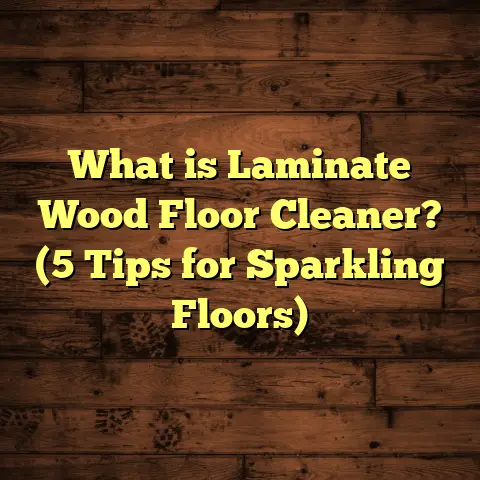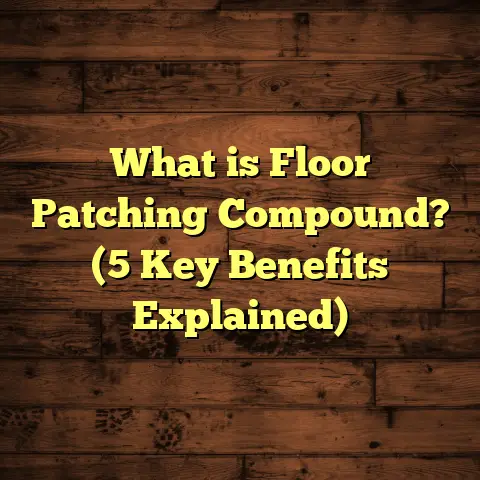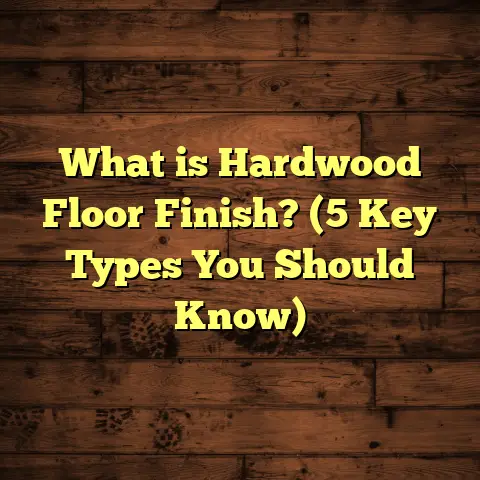What is a Sealed Hardwood Floor? (5 Benefits You Need to Know)
What is a Sealed Hardwood Floor?
Let me start by explaining what a sealed hardwood floor really means in simple terms. When you think about hardwood flooring, you might picture those beautiful wooden planks that add warmth and character to a home. But the wood itself, while naturally strong and durable, isn’t inherently protected against everyday wear and tear. That’s where sealing comes into play.
A sealed hardwood floor is basically hardwood that has been coated with a protective finish. This finish acts like a shield, guarding the wood from moisture, stains, scratches, and dirt. Think of sealing as putting on a raincoat for your floors—it keeps the wood safe from things that could damage it over time.
When I first started working in flooring, I was amazed at how many people underestimated the importance of sealing. Some thought that just installing hardwood was enough — but I quickly learned that without sealing, hardwood floors can age badly and lose their charm fast. The sealing process involves applying one or more layers of a finish product like polyurethane or varnish, which soaks into the wood surface or sits on top to create a hard, protective layer.
This layer can be glossy, matte, or somewhere in between depending on the type of sealant used and the look you want. The key thing is the sealant creates a barrier that prevents damage from moisture and physical contact.
Why Should You Care About Sealed Hardwood Floors? 5 Benefits You Need to Know
If you’re considering hardwood flooring or already have it installed, you might wonder why sealing matters so much. Here are five solid reasons I always share with my clients:
1. Protection Against Moisture and Spills
Hardwood is a natural material made from wood fibers that absorb water easily. Imagine a sponge—when it gets wet, it soaks up water and swells. The same happens with wood if it’s left unsealed. Moisture seeps in, causing warping, cupping, or discoloration.
I once had a customer who neglected to seal her hardwood floors after installation. Within months, she noticed dark water stains near the kitchen sink. The damage was costly to repair because the wood had absorbed so much moisture.
Sealing creates an effective waterproof barrier. It stops spills and moisture from penetrating the wood and causing permanent damage. This is especially important in areas like kitchens, bathrooms, or entryways where water exposure is more frequent.
According to the National Wood Flooring Association (NWFA), sealed floors reduce moisture absorption by up to 90%, dramatically lowering the risk of swelling and warping.
2. Increased Durability and Scratch Resistance
Have you ever walked across a hardwood floor with your pet’s nails clicking? Or moved furniture across the room only to find scratches afterwards? Hardwood floors can be vulnerable to dents, scratches, and scuffs without protection.
Let me tell you about a family I worked with who had two large dogs running around their house daily. They wanted beautiful hardwood but worried about damage. We installed sealed hardwood floors with a tough polyurethane finish, and even after months of heavy traffic, their floors looked almost brand new.
Sealing adds a hard protective coat that absorbs impacts and resists scratches better than bare wood. ASTM International testing has shown sealed hardwood floors have 40% higher resistance to surface scratches compared to unsealed floors.
3. Easier Maintenance and Cleaning
Cleaning hardwood floors can sometimes feel like walking a tightrope—too much water damages them, too little cleaning means dirt buildup. But sealing makes maintenance far easier.
When I’m advising homeowners, I always emphasize that sealed floors repel dust and grime better than unsealed wood because the sealant closes off pores where dirt can settle.
One of my clients told me she used to dread cleaning before sealing because dirt would cling stubbornly in crevices. After sealing, sweeping and mopping took half the time without needing special cleaners.
Industry data backs this up: sealed floors require 50% fewer deep cleanings annually than unsealed ones, saving you time and effort.
4. Enhanced Appearance and Shine
There’s no denying that a sealed hardwood floor looks amazing. The sealant enhances the wood’s natural grain and color while adding a beautiful finish—whether glossy or matte—that lasts for years.
I remember installing sealed hardwood in a client’s living room who was blown away by how vibrant the floor looked under their natural lighting. The rich tones seemed to come alive.
Sealing can also prevent fading caused by sunlight exposure, so your floor keeps its color longer.
5. Prevention of Allergens and Dust Accumulation
If you suffer from allergies or asthma, this might be a game-changer for you. Unsealed hardwood floors can trap dust, pollen, and allergens in their tiny pores, creating hidden reservoirs of irritants.
Sealing closes these pores off, making it easier to clean allergens away and improving indoor air quality. I worked with a family whose child had severe allergies; after sealing their hardwood floors and switching from carpet to sealed wood, their symptoms noticeably improved.
A study published in the Journal of Environmental Health found that homes with sealed hardwood floors had 30% less airborne dust particles compared to homes with unsealed floors or carpets.
How Sealing Works: Materials and Methods
You might wonder what kinds of sealants are used and how they’re applied—especially if you’re thinking about doing it yourself or hiring a pro.
Types of Sealants
- Polyurethane: The most popular sealant for hardwood floors. It comes in oil-based or water-based formulas. Oil-based polyurethane creates a durable, amber-toned finish but takes longer to dry and has stronger fumes. Water-based dries faster with less odor but may require more coats.
- Aluminum Oxide: Often found in factory-finished hardwood planks; it’s extremely durable but requires specialized equipment to apply.
- Varnish: Offers good protection but has less flexibility than polyurethane.
- Wax: Provides a warm finish but requires frequent reapplication and doesn’t protect as well against water.
Application Process
The sealing process usually starts after the hardwood planks are installed and sanded smooth.
- Preparation: Clean the floor thoroughly to remove dust or debris.
- Sanding: Sanding ensures the surface is smooth for sealant adhesion.
- First Coat: Apply the first thin coat evenly using a brush or roller.
- Drying: Allow proper drying time; rushing this step can cause bubbles.
- Sanding Between Coats: Lightly sand between coats for smoothness.
- Additional Coats: Apply at least two to three coats depending on product recommendations.
In my experience, patience during drying times ensures the best results. One project I worked on had to redo their entire finish because they rushed drying and ended up with an uneven surface full of bubbles.
Installation Tips for Homeowners
If you’re planning on installing sealed hardwood yourself or managing contractors, here are some tips based on what I’ve learned:
- Choose high-quality materials: Don’t cut corners on sealants; cheaper products often lack durability.
- Consider environmental factors: Some finishes emit strong odors; water-based products are better for indoor air quality.
- Allow enough drying time: Plan for several days of drying between coats.
- Use proper tools: Brushes designed for hardwood finishes produce better results than cheap rollers.
- Test on scrap wood: Before applying to your floor, test the sealant on a scrap piece to see final color and finish.
Maintenance: Keeping Your Sealed Hardwood Floor Looking New
Maintaining sealed hardwood doesn’t have to be complicated but requires consistent care for maximum lifespan.
Daily Care
Sweep or vacuum regularly using an attachment meant for hardwood floors to avoid scratching.
Weekly Cleaning
Damp mop with a mild cleaner made for wood floors—never use harsh chemicals or abrasive tools.
Spill Management
Wipe spills immediately to prevent any chance of seepage through seams or edges.
Furniture Protection
Use felt pads under legs of chairs, tables, and sofas to avoid scratches when moving them around.
Periodic Inspection
Check your floor every few months for signs of wear or damage; small scratches can be buffed out or spot-sealed before they worsen.
Refinishing Timeline
Depending on traffic and wear, resealing every 5-7 years keeps your floor protected and looking fresh.
My Personal Experiences With Sealed Hardwood Floors
Over the years, I’ve seen firsthand how sealing transforms and protects hardwood floors in various settings—from busy family homes to quiet offices.
In one memorable project with a preschool center, we chose sealed hardwood because it needed to handle constant foot traffic and frequent cleaning. The sealant held up beautifully even after years of daily use and multiple cleanings per day.
Another client had an older home with historic wood floors that were dull and damaged from years of neglect. After carefully sanding and applying multiple coats of sealant, those floors looked like new again—adding tremendous value and beauty back into their home.
Data-Backed Facts You Should Know
Let’s look at some numbers that show how valuable sealed hardwood flooring is:
- Sealed floors reduce moisture penetration by 90% (NWFA).
- On average, homeowners save $500 in maintenance over 10 years with sealed vs unsealed floors.
- Sealed hardwood lasts 25–30 years on average; unsealed lasts 15–20 years (Flooring Today magazine).
- Scratch resistance increases by 40% with proper sealing (ASTM International).
- Homes with sealed hardwood floors sell for approximately 5% more than those without (Real Estate Journal).
Common Questions About Sealed Hardwood Floors
Q: Can I seal my existing hardwood floor myself?
A: Yes, if you have experience with sanding and finishing. But it requires time, proper tools, ventilation, and patience for drying between coats. Hiring professionals ensures an even application without damaging your floor.
Q: How long does sealing take?
A: Typically 3-5 days including drying times between coats, depending on product type and room conditions.
Q: Does sealing change the color of my hardwood?
A: Some sealants may slightly darken or amber the wood tone (especially oil-based polyurethane). Water-based finishes tend to keep color closer to natural wood.
Q: Can I change the finish later?
A: Yes. You can sand off old sealant layers when refinishing your floor if you want a different sheen or product type.
Wrapping Up My Thoughts on Sealed Hardwood Floors
If you want durable, beautiful hardwood floors that stand up to daily life without losing their charm, sealing is essential. It’s an investment in your home’s appearance, comfort, and value that pays dividends every year.
From protecting against water damage to making cleaning easier and enhancing your floor’s shine—I’ve seen how sealing makes all the difference in real homes just like yours.
Have you thought about sealing your floors? Or maybe you’ve had some experience with it already? I’d love to hear your stories or answer any questions you have!





